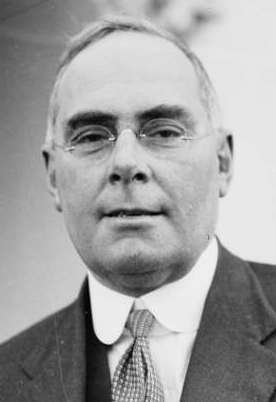
Arthur Edward Moore was an Australian politician. He was the Country and Progressive National Party Premier of Queensland, from 1929 to 1932. He was the only Queensland Premier not to come from the ranks of the Labor Party between 1915 and 1957. Although successful in achieving the unity of the conservative forces in Queensland for an extended period, Moore's abilities were tested by the onset of the Great Depression and like many other governments in Australia and elsewhere his was unable to endure the formidable challenges it posed.
This is a list of members of the 27th Legislative Assembly of Queensland from 1935 to 1938, as elected at the 1935 state election held on 11 May 1935.
This is a list of members of the 26th Legislative Assembly of Queensland from 1932 to 1935, as elected at the 1932 state election held on 11 June 1932.
The Moore Ministry was a ministry of the Government of Queensland and was led by Country and Progressive National Party (CPNP) Premier Arthur Edward Moore. It succeeded the McCormack Ministry on 21 May 1929, ten days after William McCormack's Labor government was defeated at the 1929 state election. The ministry was followed by the Forgan Smith Ministry on 18 June 1932 after the CPNP were defeated by Labor at the 1932 state election a week earlier.

Elections were held in the Australian state of Queensland on 11 June 1932 to elect the 62 members of the state's Legislative Assembly.
The Forgan Smith Ministry was a ministry of the Government of Queensland and was led by Labor Premier William Forgan Smith. It succeeded the Moore Ministry on 18 June 1932, seven days after Arthur Edward Moore's CPNP government was defeated at the 1932 state election. The ministry was followed by the Cooper Ministry on 16 September 1942 following Forgan Smith's retirement from politics.

Elections were held in the Australian state of Queensland on 15 April 1944 to elect the 62 members of the state's Legislative Assembly.

Elections were held in the Australian state of Queensland on 2 April 1938 to elect the 62 members of the state's Legislative Assembly. The Labor government of Premier William Forgan Smith was seeking a third term in office. During the previous term, the Country and United Australia parties had emerged from the united Country and Progressive National Party, which had represented conservative forces for over a decade.

Elections were held in the Australian state of Queensland on 29 March 1941 to elect the 62 members of the state's Legislative Assembly. The Labor government of Premier William Forgan Smith was seeking a fourth term in office.

Elections were held in the Australian state of Queensland on 29 April 1950 to elect the 75 members of the state's Legislative Assembly. The Labor government was seeking its seventh continuous term in office since the 1932 election; it would be Premier Ned Hanlon's second election.
The 1932 Queensland state election was held on 11 June 1932.
The 1935 state election in Queensland, Australia was held on 11 May 1935.

Elections were held in the Australian state of Queensland on 11 May 1929 to elect the 72 members of the state's Legislative Assembly. In this election, Irene Longman became the first woman to both stand and be elected into the Queensland Parliament.

Elections were held in the Australian state of Queensland on 22 May 1915 to elect the 72 members of the state's Legislative Assembly.

Elections were held in the Australian state of Queensland on 19 May 1956 to elect the 75 members of the state's Legislative Assembly. The Labor government was seeking its ninth continuous term in office since the 1932 election; it would be Vince Gair's second election as Premier.

Elections were held in the Australian state of Queensland on 3 August 1957 to elect the 75 members of the state's Legislative Assembly. The major parties contesting the election were the Queensland Labor Party led by Premier Vince Gair, the Labor Party led by former Deputy Premier Jack Duggan, and the Country-Liberal coalition led by Frank Nicklin.

Elections were held in the Australian state of Queensland on 12 May 1923 to elect the 72 members of the state's Legislative Assembly. The Labor government was seeking its fourth continuous term in office since the 1915 election; it would be Premier Ted Theodore's second election.

Elections were held in the Australian state of Queensland on 28 May 1960 to elect the 78 members of the state's Legislative Assembly. The election followed the enactment of the Electoral Districts Act 1958 which increased the Assembly from 75 to 78 seats and modified the zonal system first established by Labor ahead of the 1950 election.

Elections were held in the Australian state of Queensland on 8 May 1926 to elect the 72 members of the state's Legislative Assembly. The Labor government was seeking its fifth continuous term in office since the 1915 election. William McCormack was contesting his first election as Premier.

Elections were held in the Australian state of Queensland on 9 October 1920 to elect the 72 members of the state's Legislative Assembly. The Labor government was re-elected to its third term in office, having been in power since the 1915 election. It was Ted Theodore's first election as premier, following his election in 1919 to succeed T. J. Ryan as Labor leader.













